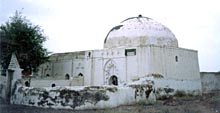
The Shrine of the Owais Al-Qarnee One of the Outstanding, Islamic & Archeological Monuments in Yemen [Archives:1999/36/Culture]
September 6 1999
Saleh Abdulbaqi
Cultural Editor

In this cultural article of this issue, I will be focusing on an important milestone of our Islamic culture at Zabeed, Al-Fakeeh House, in Hodeidah. It is the grave of the holy man, Owais Al-Qarnee. His grave is a pivotal monument highly appreciated and admired by Yemenis as well as Pakistani and Indian Muslims who have annual festivals in this place. When writing this article, I also made use of a good book called “The Feature Layers of the Honest and Faithful People” by Abo Al-Abass Ahmad Al-Zabeedi.

Then, he pronounced the name Owais and when they inquired about his identity, he said that he suffered from leprosy, had bluish-black eyes, broad shoulders, a long beard, he used to always look at his praying place and cry over himself. There was a bright spot under his left shoulder, which was a unique mark of his. However, he was very well known to be among the most faithful in heaven. So the Prophet asked Omar bin Al-Khatab as well as Ali bin Abo Taleb “May God bless them” if they could meet him one day and ask him to ask God to forgive their sins. When the Prophet Mohammed passed away, Omar and Ali kept looking for him for almost ten years. However, they could not find him at all. In the same year of Omar’s death, a person called Abo Kaiss went at the top of a mountain in Yemen and shouted as loud as he could asking whether the natives know someone called Owais. They told him that there was no one called so, then a person turned up and said that he had a poor nephew called Owais but he was a mere camel peasant.

During the caliphate of Ali, he participated in Islamic conquests. He was said to have died in Safeen during the caliphate of Ali bin Abi Taleb rule in 37. It is also said that he used to pray for long periods of time to the extent that he used to spend the whole day and night praying to God and asking for his forgiveness.

The dome which appears in the picture was rebuilt after it was destroyed in the 12th century (1320). When I inquired why the shrine was mostly visited by Pakistani and Indian Muslims, I was told that when Indians used to go to Al-Haj in the past, they used to moor their ships at Mocha, in Hodeidah. Then, they walked the rest of the way to Saudi Arabia through Yemen, as there were no means of transportation at that time. On their way, they used to pass by this holy shrine. They were very attracted to it for it was eloquently decorated. They used to stay there for many days before continuing their journey to Mekka. Thus, Indians and Pakistanis inherited the conventions of visiting this shrine. Today, visiting Owais’s shrine has become a practice done every year.
To sum it all up, this Islamic shrine of this virtuous and holy man should be given some attention and care. We pronounce this plea for those in charge to keep and preserve such Islamic, historical and archeological monuments for we will never achieve anything in the future without preserving our past which was very fertile and rich.
——
[archive-e:36-v:1999-y:1999-d:1999-09-06-p:./1999/iss36/culture.htm]


